
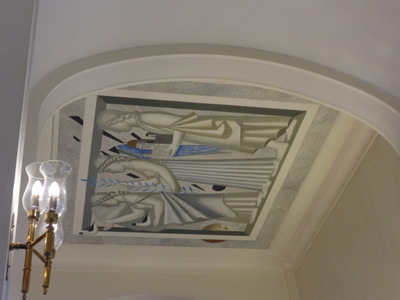 The decor at the Angleterre was pretty resolutely Art Deco, as these samples show, though it ran more to Greek mythology than to anything to do with England.
The decor at the Angleterre was pretty resolutely Art Deco, as these samples show, though it ran more to Greek mythology than to anything to do with England.Sunday, 13 August, St. Petersburg: last day!
Written 10 October 2017

 The decor at the Angleterre was pretty resolutely Art Deco, as these samples show, though it ran more to Greek mythology than to anything to do with England.
The decor at the Angleterre was pretty resolutely Art Deco, as these samples show, though it ran more to Greek mythology than to anything to do with England.
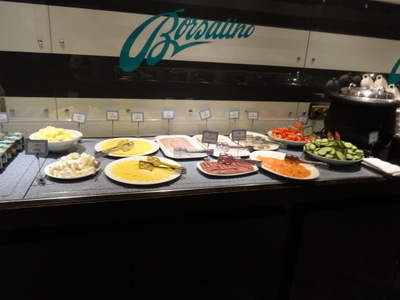
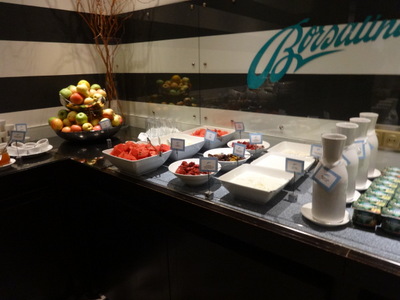 The breakfast there was a pretty extensive buffet, hidden away in a side room off the dining room. It included the usual array of cold cuts, sliced cheeses, herring, salmon and vegetables and several kinds of yogurt/kefir/sour cream with stewed fruits, cut fresh fruit, and whole fresh fruit.
The breakfast there was a pretty extensive buffet, hidden away in a side room off the dining room. It included the usual array of cold cuts, sliced cheeses, herring, salmon and vegetables and several kinds of yogurt/kefir/sour cream with stewed fruits, cut fresh fruit, and whole fresh fruit.
Another wall held coffee urns and dispensers full of three or four different fruit juices.
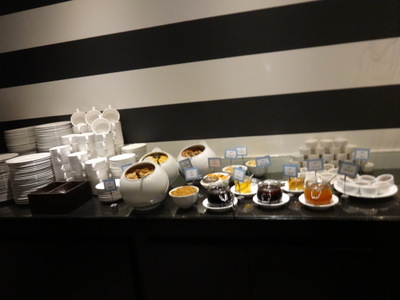
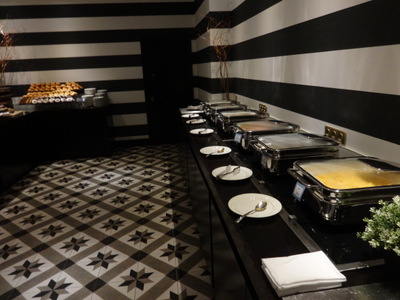 Cold cereals with various add-ins like brown sugar, seeds, and nuts; several jams and honeys. Several chafing dishes of hot cereals.
Cold cereals with various add-ins like brown sugar, seeds, and nuts; several jams and honeys. Several chafing dishes of hot cereals.
A whole row of larger chafing dishes offered scrambled eggs, bacon, several kinds of sausages, potatoes, tomatoes, mushrooms, etc. At the left edge of the right-hand photo you can see a little of the extensive bread offerings: several flavors of sliced bread, several flavors of rolls, baguettes, bagels, muffins, and all the usual viennoiseries.
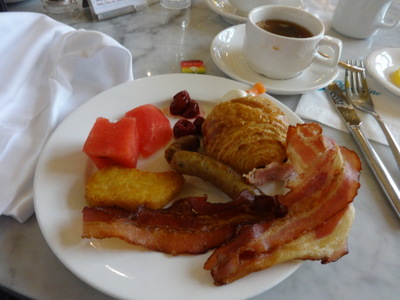
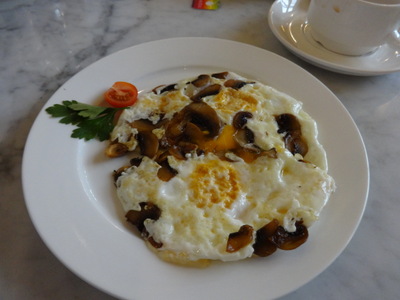 Here's my plate from the buffet: watermelon, stewed sour cherries, a pain au chocolat hiding a small piece of salmon with sour cream, bacon, a sausage, and an oddly shaped cake of hash browns.
Here's my plate from the buffet: watermelon, stewed sour cherries, a pain au chocolat hiding a small piece of salmon with sour cream, bacon, a sausage, and an oddly shaped cake of hash browns.
At the right is my eggs-to-order plate. The scrambled eggs didn't look auspicious, so I asked for eggs over medium with mushrooms, and the result was excellent.
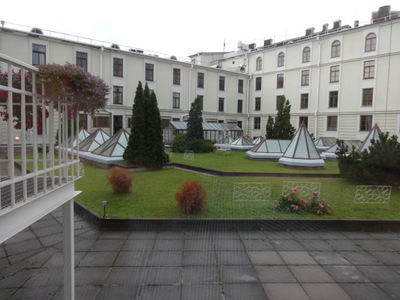
 At the left here is a view into the hotel's inner courtyard; I never found out what the pyramidal skylights let light into.
At the left here is a view into the hotel's inner courtyard; I never found out what the pyramidal skylights let light into.
At the left here is a better photo of Nicholas I, in the middle of the blue bridge, which we crossed on our way to our morning's destination.
The plan all along had been to spend this day going back to the Hermitage, as we knew from experience that Viking never allowed enough time in art museums, but when the time came, two factors changed our minds. First, in the General Staff building, we really did get to see the whole collection from the period we were most interested in, and second, we had seen the line that forms every day outside the entrance to the main building. Without Viking's help, we would truly have spent half the day just getting in.

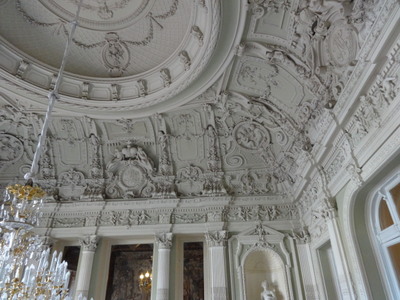 So we reviewed our options and settled on the YUsupov palace, the residence of an immensely rich family. In their will, the Yusupovs specified that if their line were abruptly terminated, everything they owned, both tangible property and real estate, would go to the state, which it has. The façade is shrouded in scaffolding for restoration, but the interior is gorgeous. At the left here is part of the huge double grand staircase near the entrance.
So we reviewed our options and settled on the YUsupov palace, the residence of an immensely rich family. In their will, the Yusupovs specified that if their line were abruptly terminated, everything they owned, both tangible property and real estate, would go to the state, which it has. The façade is shrouded in scaffolding for restoration, but the interior is gorgeous. At the left here is part of the huge double grand staircase near the entrance.
At the right is part of the ceiling over the staircase; I couldn't managed to get a good shot of the whole thing because it's so big!
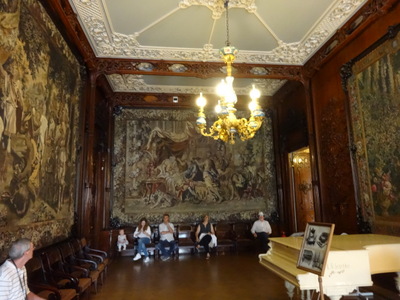
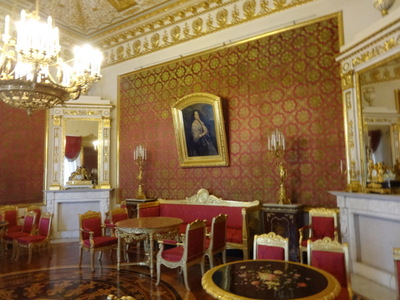 At the left here, David (far right), Rachel (with the white sweater on her lap), and Ev (foreground left) rest their feet in the "tapestry room." Originally, the walls were actually hung with tapestries, but now they are covered with paintings of tapestries.
At the left here, David (far right), Rachel (with the white sweater on her lap), and Ev (foreground left) rest their feet in the "tapestry room." Originally, the walls were actually hung with tapestries, but now they are covered with paintings of tapestries.
At the right is the "red parlor." The tour was not guided, but at the entrance to each room and excellent information panel gave details. For example, in the red parlor, the "wallpaper" is silk damask made in Russia; the paintings on the ceiling are based on the Iliad and are by Barnaba Medici and Pietro Scotti; the gilded bronze and glass chandelier was made in St. Petersburg in Pierre ueuder's workshop; the parquet was made in Russia of various fine tropical woods; and the furniture was made in Russia—all these date from the 1830s. The early-19th century gilded bronze candelabra was made in France by Louis-Philippe Feuchères; the Mars and Venus clock, also gilded brnze was made in Pierre Victor Ledure's workshop in France in 113; and the portrait of Zinaida Yusupova over the sofa is a modern copy (the 1858 original by Louis-douard Dubufe is in the collectin of the Pavlovsk State Museum. All the (dozens of) rooms were like that.
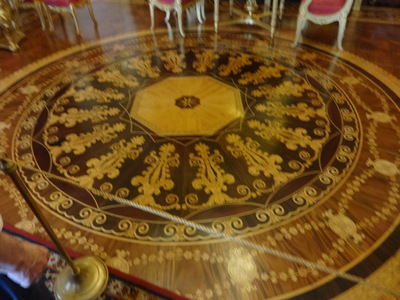
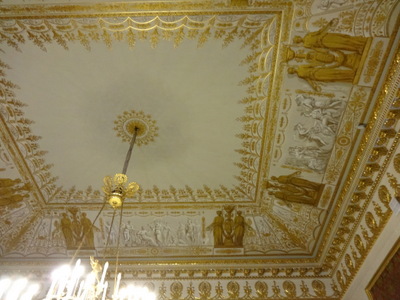 Here's a better view of the parquet in the red parlor.
Here's a better view of the parquet in the red parlor.
And a view of its ceiling, with the scenes from the Iliad around the edges.

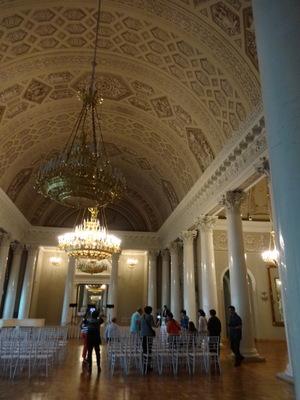 This is the fireplace in the green parlor. It was made of malachite in 1860, in "Russian mosaic technique" with bronze trim.
This is the fireplace in the green parlor. It was made of malachite in 1860, in "Russian mosaic technique" with bronze trim.
At the right is the banquet hall, aka the white-columned hall. Strangely, its huge chandeliers are made of gilded papier maché.
We also passed through the beautiful wood-paneled library. The Yusupovs had a 55,000-book library, but it was housed in several different palaces, so only a fraction of it would have been accommodated here.
Written 14 October 2017

 In a hallway, we passed this Yusupov family tree, this one arranged with the oldest at the top and most recent at the bottom. The bottom three thumbnail portraits are definitely photographs (two of them in color), and the row above them may be, as well. The originator of the family lived 1480-1555, and the current scion, at the bottom, is Tatyana Sfiris, born in 1968. No dates are given for her father, but her mother, Ksenia Yusupova Sfiris (if I'm transliterating that right) was born in 1942 and was still living when the tree was last updated. According to Wikipedia, Tatyana now has two daughters.
In a hallway, we passed this Yusupov family tree, this one arranged with the oldest at the top and most recent at the bottom. The bottom three thumbnail portraits are definitely photographs (two of them in color), and the row above them may be, as well. The originator of the family lived 1480-1555, and the current scion, at the bottom, is Tatyana Sfiris, born in 1968. No dates are given for her father, but her mother, Ksenia Yusupova Sfiris (if I'm transliterating that right) was born in 1942 and was still living when the tree was last updated. According to Wikipedia, Tatyana now has two daughters.
The lady in the gorgeous portrait at the right (Zenaida Yusupova) is the middle entry in the fifth row from the bottom. Her older son, Prince Felix Felixovich Yusupov, described by Wikipedia as "the wealthiest man in Imperial Russia," married the only niece of Tsar Nicholas II. (Nicholas is second from the left in the fourth row from the bottom). Felix was also one of those who killed Rasputin, in the cellars of this very palace. The portrait of Zenaida is a modern copy; the original is in State Historical Museum in Moscow (remember the red brick building at one end of Red Square?).
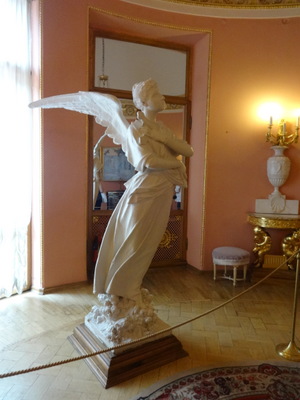
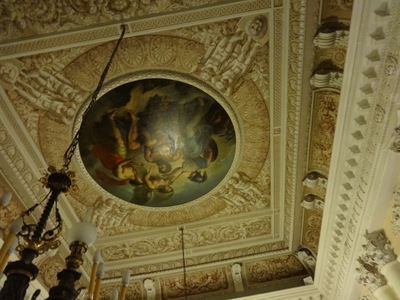 This 19th century plaster sculpture of the Angel of Grief is a model for the tombsteon of Tatiana Yusupova. It's located in the room called the "Minor Rotunda."
This 19th century plaster sculpture of the Angel of Grief is a model for the tombsteon of Tatiana Yusupova. It's located in the room called the "Minor Rotunda."
At the right is the ceiling of the Antonio Vigi Hall. It depicts the Triumph of Hercules and is by Antonio Vigi, late 18th–early 19th century. All the "relief" sculpture that surrounds the central medallion is trompe l'oeuil, painted on a flat surface.

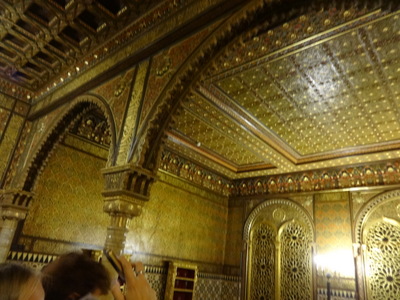 One suite of rooms (including the billiard room, not shown here) was decorated and furnished in Moorish style.
One suite of rooms (including the billiard room, not shown here) was decorated and furnished in Moorish style.
The basin looks big enough to have been a bath, but in fact it was only a fountain. The ceiling was described as being made of "carton-pierre" (cardboard-stone? Sure enough, Wikipedia says that's "papier-mâché decorated in imitation of wood, stone, or metal, and chiefly used for ornamental statuary or decorative motifs").
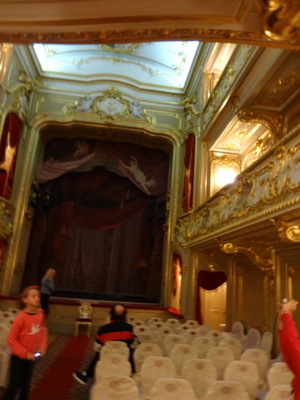
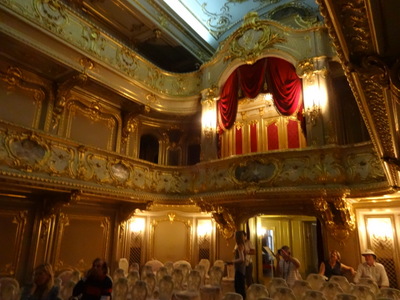 Perhaps the most spectacular room of the tour was the home theater. This view of the tage is pretty dark, but you can see the row of seats on the floor as well as the two rows of boxes that run down both sides. The arch over the proscenium is painted with angles holding up a painted drapery, but a real curtain hides the stage.
Perhaps the most spectacular room of the tour was the home theater. This view of the tage is pretty dark, but you can see the row of seats on the floor as well as the two rows of boxes that run down both sides. The arch over the proscenium is painted with angles holding up a painted drapery, but a real curtain hides the stage.
It's even more spectacular looking back the other way, toward the royal box at the rear of the house. Ev, Rachel, and David are resting their feet in the last two rows of seats on the right.
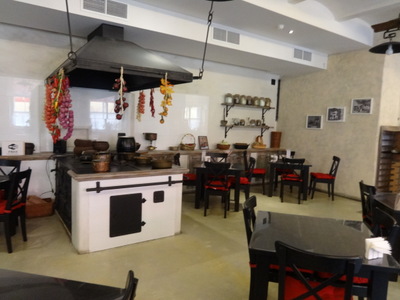
 After our feet had taken as much touring as they could for the morning, we repaired to the extensive cellars, which now accommodate a bakery/coffee shop; the restrooms; several cloak-rooms, both manned and self-service; and in the palace's original kitchens, the lunch counter.
After our feet had taken as much touring as they could for the morning, we repaired to the extensive cellars, which now accommodate a bakery/coffee shop; the restrooms; several cloak-rooms, both manned and self-service; and in the palace's original kitchens, the lunch counter.
At the left here is the main kitchen. The stove is now surrounded by table and chairs for lunching tourists. Additional wall ovens and cooking surfaces were building into neighboring rooms, as well.
The fare at the lunch counter consisted pretty much entirely of piroshkis, brioche-dough pies filled with meat, vegetables, and/or fruit. The lady manning the counter spoke no English, but the various trays of pies were labeled in English and Russian, and we were able to point to the bottled water. I chose a meat pie and a cherry one. Ev had a problem, though. All the savory pies were likely to contain onions and garlic, and we had no way of asking about them, so he decided to make do with just a cherry pie and some other safe item (I forget what; maybe a baloney sandwich from Rachel's purse?). Anyway, after I ate my meat pie, I bit into the cherry one, just in time to warn Ev, who was about to do the same, that it was in fact filled with potato, cabbage, and yes, sliced onion. Drat. Apparently, the little signs were not all arranged on the proper platters. Ev went back to the counter to try to explain that he wanted a cherry pie and that the platter labeled cherry wasn't. He got nowhere, but another couple approached just at that moment, speaking Russian. He asked whether they spoke English; they didn't but asked whether he spoke French, so he came and got me. Through the lady who spoke both Russian and French, we explained to the lunch-counter lady, who refused to move the signs but grudgingly agreed to let Ev trade in his cabbage piroshki for a cherry one, which she pulled off another platter in the back. At least he got something to eat.
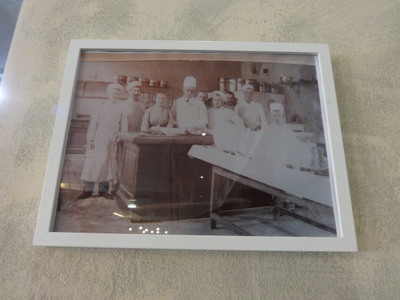
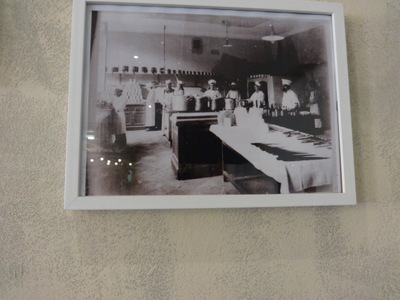 On the walls of the kitchens were old photos showing them in operation. Here are two, presumably taken at different times. Each shows a a different crew of nine, including both men and women, posing proudly with their equipment.
On the walls of the kitchens were old photos showing them in operation. Here are two, presumably taken at different times. Each shows a a different crew of nine, including both men and women, posing proudly with their equipment.
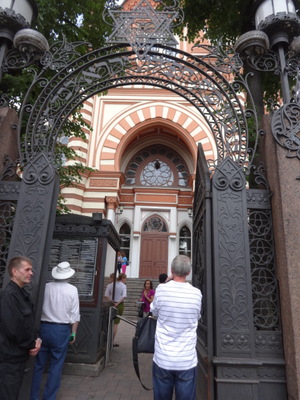
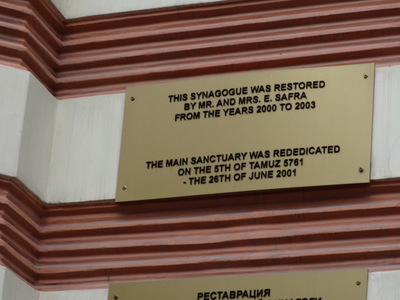 The afternoon was devoted to a must-see for Rachel—the St. Petersburg synagogue. Here we are entering the wrought-iron gates of its front courtyard, just as a large bus tour was leaving. No other groups were due, but the guide assured us that they conducted guided tours on demand, so long as a guide who spoke the right language was on hand. The group just leaving spoke English (from New York, according to their accents), so the same guide gave us a private tour.
The afternoon was devoted to a must-see for Rachel—the St. Petersburg synagogue. Here we are entering the wrought-iron gates of its front courtyard, just as a large bus tour was leaving. No other groups were due, but the guide assured us that they conducted guided tours on demand, so long as a guide who spoke the right language was on hand. The group just leaving spoke English (from New York, according to their accents), so the same guide gave us a private tour.
This plaque in the front lobby commemorates the reconstruction of the synagogue during 2000–2003 by Mr. and Mrs. Edmond J. Safra. Safra was .an American banker, half Brazilian and half Lebanese, who lived in New York. His portrait hung on another wall.
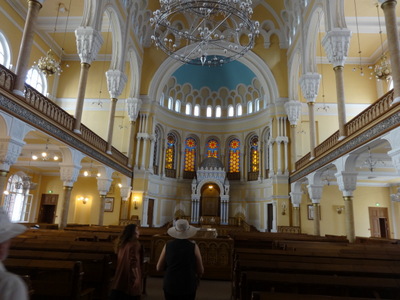
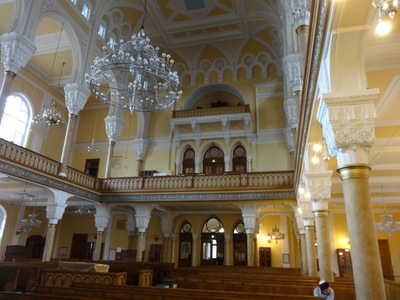 The synagogue is the second largest in Europe, after the one in Budapest. The Jewish community in St. Petersburg dates from 1802. This building was finished in 1893.
The synagogue is the second largest in Europe, after the one in Budapest. The Jewish community in St. Petersburg dates from 1802. This building was finished in 1893.
Currently, about 80,000 people with Jewish roots live in St. Petersburg. No pogroms ever occurred here, as they did in smaller places. A few years ago, a couple of attacks on orthodox Jews occurred, but in general the city is quite safe for Jews. The synagogue was not closed for more than a week during the Soviet era, although it was frequently threatened with closure, and it was not seriously damaged during the war.
These two views are of the main sanctuary, at the left from the entrance toward the front and on the right facing the other way, back toward the entrance.
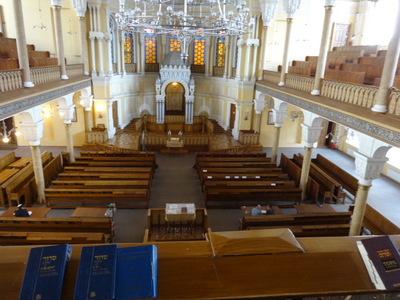
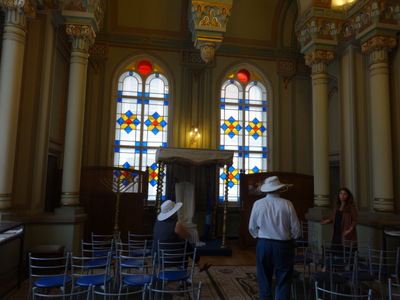 The view at the left here is of the same room from the upper gallery, originally where women sat for the service.
The view at the left here is of the same room from the upper gallery, originally where women sat for the service.
The photo at the right is of the wedding room. It has a permanent chuppah (wedding canopy), but couples are free to bring their own if they prefer.
Family who can afford it send their boys to the holy land for their bar mitzvahs. For girls, the community has a sort of community bat mitzvah, really just a birthday party; girls don't get to read from the Torah from the bima or get sent to Jerusalem.

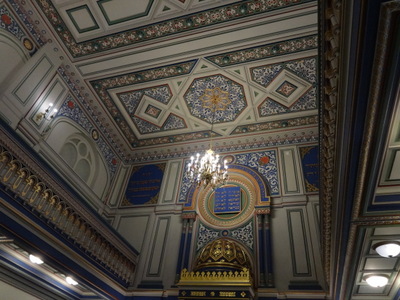 The synagogue also has a smaller sanctuary, restored only a few years ago, seen here in two views.
The synagogue also has a smaller sanctuary, restored only a few years ago, seen here in two views.
In addition, the building houses a small museum. There's also a mikvah (ritual bath) here, as well as another in the northern part of the city.
Sadly, these days, despite the large Jewish population of the city, the synagogue is never filled, even on high holy days. Jews are no longer concentrated in a few neighborhoods near the center of the city, and few live near enough to walk to this building. Even those who drive to services prefer suburban synagogues. where parking is easier.
Because this is technically an orthodox synagogue (although anyone is welcome to attend) managed by an organization called Chabad, no mixed marriages are permitted, so those couples have to go to Moscow or elsewhere to find a more liberal. St. Petersburg's main rabbi is American; is the one in Moscow is Swiss, and the one for the whole country is Italian.
St. Petersburg University has a small school of Jewish studies. Of a recent year's 11 graduates, only one was actually jewish.

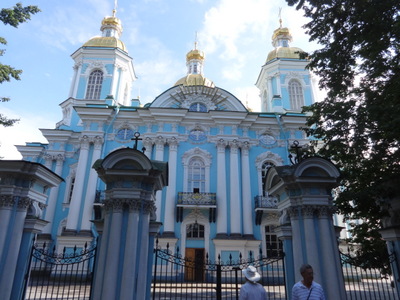 In the lobby was a beautiful gift shop, where Rachel added yet more items to her store of gifts for the folks back home.
In the lobby was a beautiful gift shop, where Rachel added yet more items to her store of gifts for the folks back home.
On our walk back to the hotel, we got a closer view of the breautiful Wedgewood-blue-and-white St. Nicholas cathedral, but we never did get a chance to go inside.
On the way back from our gift-shopping foray to St. Isaac's the previous day, Rachel and I took time to scope out the restaurants in the neighboring Four Seasons and Astoria hotels and decided that the menu looked best at the Astoria, so that's where we went for dinner.
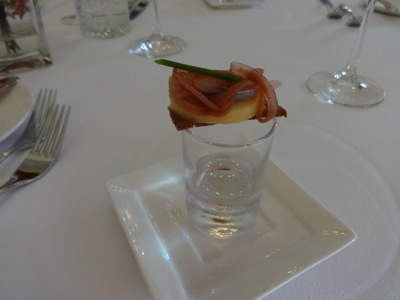
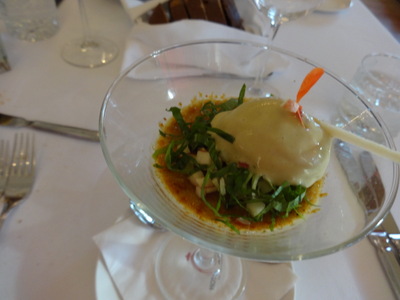 For some reason, the place was mostly deserted, so we had the almost undivided attention of our waiter and the maitre d', a charming young woman with excellent English.
For some reason, the place was mostly deserted, so we had the almost undivided attention of our waiter and the maitre d', a charming young woman with excellent English.
The amuse-bouche was a glass of vodka topped with a thin slice of dark bread toast, a slice of potato, a slice of smoked fish, a few pickled onion rings, and a chive. Needless to say, a brisk trade broke out around the table. I got Ev's onions, Ev got Rachel's fish, Rachel got my vodka, etc.
I had the three-course "chef's choice" menu, so my starter was foie gras crème brulée with pistachio ice cream and green apple salad. Quite good, although quite sweet, and not very foie-gras flavored.
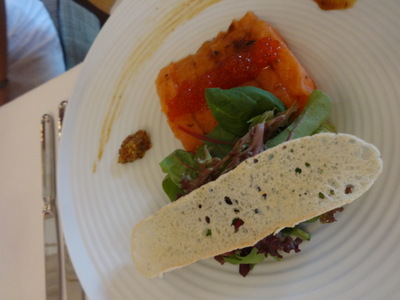
 David had the salmon starter, topped with salmon caviar and accompanied by a small salad and a dab of coarse-grained mustard.
David had the salmon starter, topped with salmon caviar and accompanied by a small salad and a dab of coarse-grained mustard.
Ev ordered the cheese platter, which turned out to be huge, providing enough for the whole table and still leaving leftovers. As you can see, it included six or seven different cheeses as well as apples, pears, grapes, walnuts, and a dish of honey.
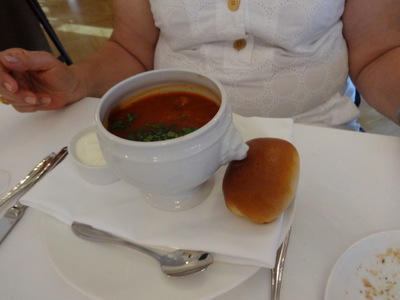
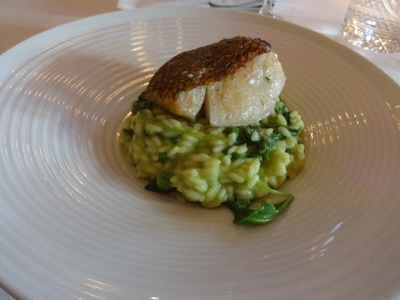 Rachel, true to form, went for another bowl of broscht, served with a dish of sour cream and a miniature meat piroshki.
Rachel, true to form, went for another bowl of broscht, served with a dish of sour cream and a miniature meat piroshki.
At the right is my main course, a thick chunk of Chilean sea bass atop a green-pea risotto with mint and lemon-butter sauce.
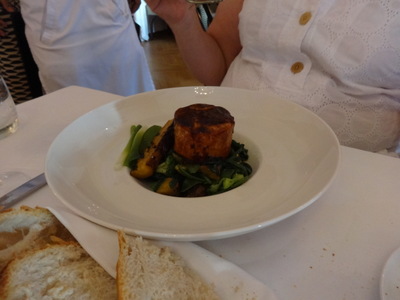
 Rachel's main course was turkey ballotine with truffle filling, truffle sauce, and baby vegetables. To the left of the cylindrical ballotine, you can see grilled baby leeks and a grilled spear of eggplant. Under it were little potatoes, carrots, greens, etc.
Rachel's main course was turkey ballotine with truffle filling, truffle sauce, and baby vegetables. To the left of the cylindrical ballotine, you can see grilled baby leeks and a grilled spear of eggplant. Under it were little potatoes, carrots, greens, etc.
David tried the beef Stroganoff, which came topped with sour cream and scallions, with mashed potatoes on the side.
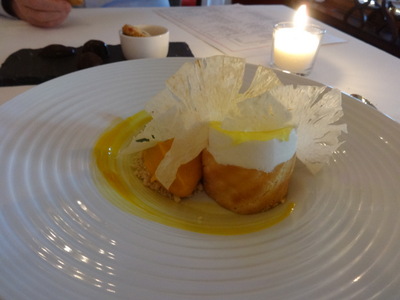
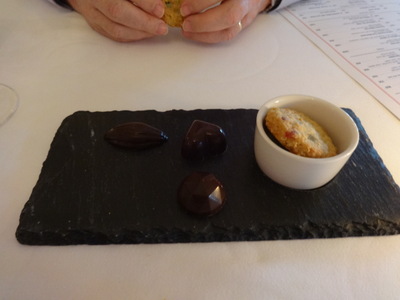 Dessert with the chef's choice menu was tropical mousse with passion-fruit filling and home-made mango sorbet. It turned out to be a frozen concoction topped, as you can see, by crisp, paper-thin slices of dried pineapple. The bottom was wrapped in cake, and the sweet mango sorbet set off the rather sharp passion-fruit center. Very good.
Dessert with the chef's choice menu was tropical mousse with passion-fruit filling and home-made mango sorbet. It turned out to be a frozen concoction topped, as you can see, by crisp, paper-thin slices of dried pineapple. The bottom was wrapped in cake, and the sweet mango sorbet set off the rather sharp passion-fruit center. Very good.
The mignardises were outstanding house-made dark chocolates, accompanied by a couple of house-made cookies. Rachel sweet-talked the maitre d' into giving us about three rounds of the chocolates, in addition to four tiny paper boxes for us to take home, each containing two more.
We had a long chat with her after we finished eating. She's happy with the present state of affairs, but confirmed what we had heard elsewhere—that her mother and people of that generation are often nostalgic for Soviet times. Back then, you were guaranteed a job and a place to live, free health care, and free school for your kids as far as their abilities would take them. Now, they feel as though they've been thrown out to sink or swim—find your own job, if you can; find your own apartment, in a price range the job you were able to land will pay for (and commute farther if you want a less expensive place); pay for your own health care; and beyond a certain level, depending on where and what they want to study, pay for your kids' education. Hard to get used to.